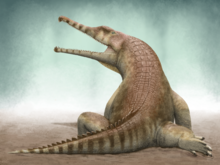| Angistorhinus Temporal range:
| |
|---|---|

| |
| Angistorhinus skull | |
| Scientific classification | |
| Domain: | Eukaryota |
| Kingdom: | Animalia |
| Phylum: | Chordata |
| Class: | Reptilia |
| Clade: | Archosauromorpha |
| Clade: | Archosauriformes |
| Order: | †Phytosauria |
| Family: | †Parasuchidae |
| Genus: | †Angistorhinus Mehl, 1913 |
| Species | |
| |

Angistorhinus (meaning "narrow snout" or "hook snout") is an extinct genus of phytosaur known from the Late Triassic period of Texas and Wyoming, United States. It was first named by Mehl in 1913 and the type species is Angistorhinus grandis.[1] Other species from Texas and Wyoming, A. alticephalus (Stovall and Wharton, 1936), A. gracilis (Mehl, 1915) and A. maximus (Mehl, 1928), are cospecific with the type species.[2] Angistorhinus is known from the holotype UC 631, partial skull and lower jaws recovered from the Popo Agie Formation, Chugwater Group, Wyoming and from the associated paratype UM 531, a partial skull, TMM 31098-1, skull and lower jaws and ROM 7977, partial skull and lower jaws, recovered from the 'Pre-Tecovas Horizon' in the Dockum Group, Texas. A possible second species, A. talainti is known from the Triassic of Morocco.[3] In 1995, Long and Murry created the new combination, Angistorhinus megalodon by synonymy for Brachysuchus.[4] Hungerbühler and Sues (2001) hypothesised that Angistorhinus is a junior synonym of Rutiodon.[5] However, in 2010 Michelle R. Stocker retained the validity of Brachysuchus and of A. grandis.[6]
Description

Angistorhinus was another of the early phytosaur genera. It was similar to Parasuchus but differed in having the nostrils located further back, towards and above the eyes. This was a more specialized condition that characterized all late phytosaurs. Angisthorhinus was a huge animal by any standards; the skull length was about 120–124 cm; estimated overall length 7 to 8 meters, more in A. megalodon, a very large, short and heavy-muzzled form sometimes given its own genus (Brachysuchus), and which far exceeded in size any living crocodile.[7]
References
- ^ Mehl, M. G. (1913). "Angistorhinus, a new genus of Phytosauria from the Trias of Wyoming". Journal of Geology. 21 (2): 186–191. Bibcode:1913JG.....21..186M. doi:10.1086/622049. S2CID 129008996.
- ^ S. G. Lucas; A. B. Heckert & R. Kahle (2002). A. B. Heckert & S. G. Lucas (eds.). "Postcranial anatomy of Angistorhinus, a Late Triassic phytosaur from West Texas". Upper Triassic Stratigraphy and Paleontology, New Mexico Museum of Natural History and Science Bulletin. 21: 157–164.
- ^ Dutuit, J.-M. (1977). "Description du craˆne de Angistorhinus talainti n. sp. un nouveau Phytosaure du Trais atlasique marocain". Bulletin du Muséum National d'Histoire Naturelle. 3 (489): 297–336.
- ^ Long, R. A. & Murry, P. A. (1995). "Late Triassic (Carnian and Norian) tetrapods from the southwestern United States". Bulletin of the New Mexico Museum of Natural History and Science. 4: 1–254.
- ^ Hungerbühler, A. & Sues, H.-D. (2001). "Status and phylogenetic relationships of the Late Triassic phytosaur Rutiodon carolinensis". Journal of Vertebrate Paleontology. 21 (3 Suppl): 64A. doi:10.1080/02724634.2001.10010852. S2CID 220414868.
- ^ Michelle R. Stocker (2010). "A new taxon of phytosaur (Archosauria: Pseudosuchia) from the Late Triassic (Norian) Sonsela Member (Chinle Formation) in Arizona, and a critical reevaluation of Leptosuchus Case, 1922". Palaeontology. 53 (5): 997–1022. doi:10.1111/j.1475-4983.2010.00983.x. S2CID 83536253.
- ^ "Palaeos Mesozoic: Triassic: Late Triassic: Carnian - 2". Archived from the original on 2013-12-24. Retrieved 2012-05-25.
